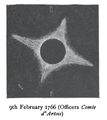| Solar eclipse of February 9, 1766 | |
|---|---|
 Map Map | |
| Type of eclipse | |
| Nature | Total |
| Gamma | −0.6598 |
| Magnitude | 1.0352 |
| Maximum eclipse | |
| Duration | 147 s (2 min 27 s) |
| Coordinates | 50°42′S 26°36′E / 50.7°S 26.6°E / -50.7; 26.6 |
| Max. width of band | 156 km (97 mi) |
| Times (UTC) | |
| Greatest eclipse | 12:09:44 |
| References | |
| Saros | 117 (55 of 71) |
| Catalog # (SE5000) | 8954 |
A total solar eclipse occurred on Sunday, February 9, 1766. A solar eclipse occurs when the Moon passes between Earth and the Sun, thereby totally or partly obscuring the image of the Sun for a viewer on Earth. A total solar eclipse occurs when the Moon's apparent diameter is larger than the Sun's, blocking all direct sunlight, turning day into darkness. Totality occurs in a narrow path across Earth's surface, with the partial solar eclipse visible over a surrounding region thousands of kilometres wide.
Observations
Related eclipses
It is a part of solar Saros 117.
References
- Mabel Loomis Todd (1900). Total Eclipses of the Sun. Little, Brown.
- NASA chart graphics
- Googlemap
- NASA Besselian elements



